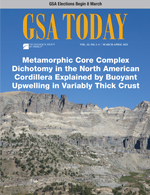Abstract View
Volume 33 Issue 3-4
(March-April 2023)
GSA Today
Article, p. 4-11 | Full Text
| PDF
Metamorphic Core Complex Dichotomy in the North American Cordillera Explained by Buoyant Upwelling in Variably
Thick Crust
Andrew V. Zuza
Nevada Bureau of Mines and Geology, University of Nevada, Reno, Nevada 89557, USA, azuza@unr.edu
Wenrong Cao
Dept. of Geological Sciences and Engineering, University of Nevada, Reno, Nevada 89557, USA
Abstract
Metamorphic core complexes (MCC) in the North American Cordillera exhibit a strong dichotomy. Those in the
north formed in a thickened orogenic plateau during Paleogene Farallon subduction, are widely spaced (~200
km), and young SW. Conversely, those in the south formed in thinner crust, are closely spaced (~50 km),
developed during the Oligocene-Miocene transition to regional transtension, and young NW. Synthesis of
magmatism and cooling ages, modeling, and plate reconstructions demonstrate that MCCs could have initiated
as buoyant domes driven by lower-crust heating caused by asthenospheric upwelling after Farallon slab
rollback. These domes were later exhumed by Miocene extension. The widely spaced Paleogene hinterland domal
upwellings and associated mylonites were temporally decoupled from Miocene detachments, manifesting a
two-stage development. The closely spaced Oligocene-Miocene foreland MCCs show almost synchronized doming
and detachment faulting. The spacing dichotomy of the MCCs reflects the characteristic wavelength of the
doming process that was in turn controlled by the thickness and thermal state of the crust.
Manuscript received 12 July 2022. Revised manuscript received 8 Sept. 2022.
Manuscript accepted 15 Sept. 2022. Posted 1 Nov. 2022.
© The Geological Society of America, 2022. CC-BY-NC.
https://doi.org/10.1130/GSATG548A.1
Cover Image

Search Google Scholar for
Search GSA Today
